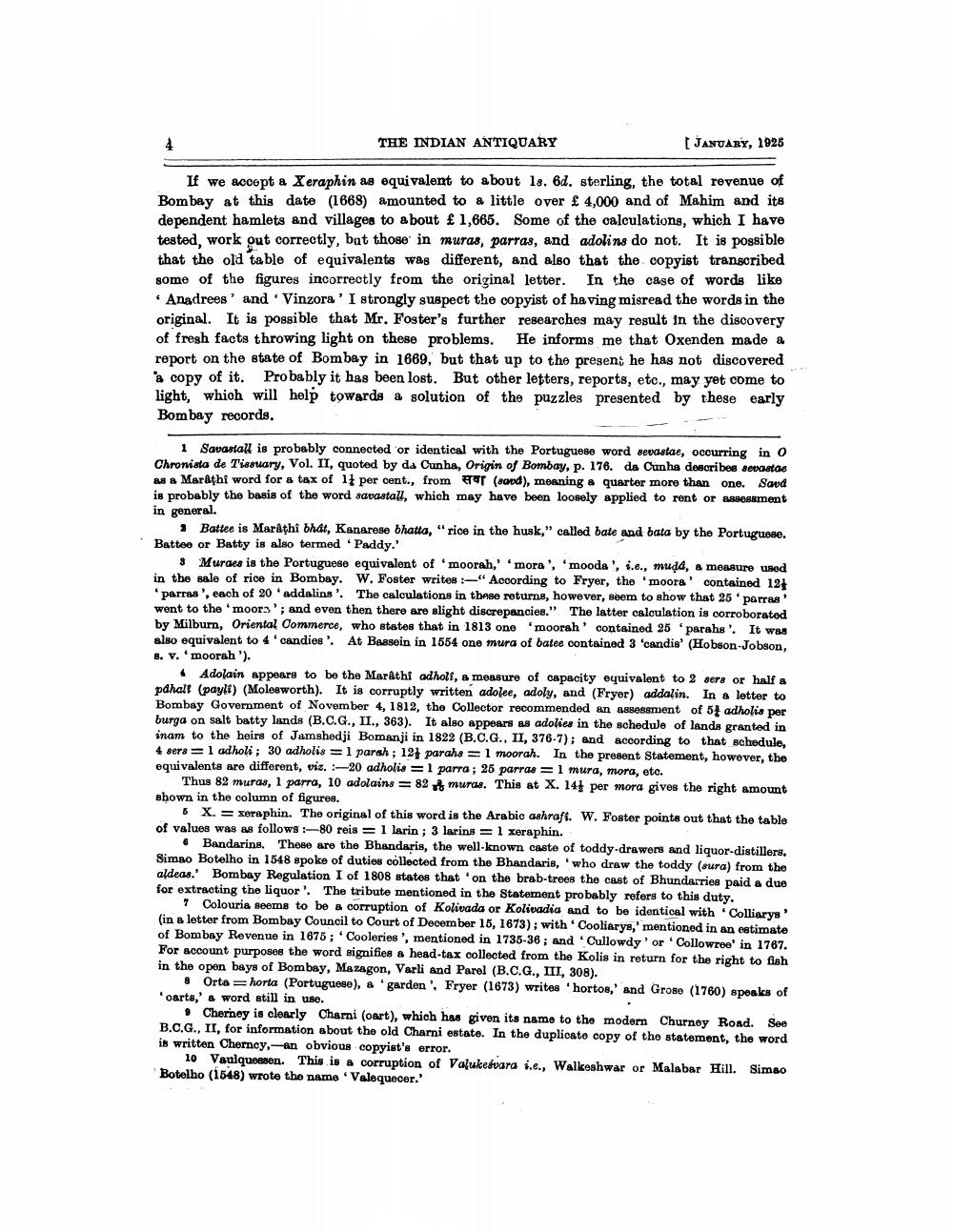________________
THE INDIAN ANTIQUARY
JANUARY, 1926
If we accept a Xeraphin as equivalent to about 18. 6d. sterling, the total revenue of Bombay at this date (1668) amounted to a little over £4,000 and of Mahim and its dependent hamlets and villages to about £ 1,665. Some of the calculations, which I have tested, work out correctly, but those in nuras, parras, and adolins do not. It is possible that the old table of equivalente was different, and also that the copyist transcribed some of the figures incorrectly from the original letter. In the case of words like • Anadrees' and 'Vinzora' I strongly suspect the copyist of having misread the words in the original. It is possible that Mr. Foster's further researches may result in the discovery of fregh facts throwing light on these problems. He informs me that Oxenden made a report on the state of Bombay in 1669, but that up to the presen; he has not discovered à copy of it. Probably it has been lost. But other letters, reports, etc., may yet come to light, which will help towards a solution of the puzzles presented by these early Bombay records.
1 Savastall is probably connected or identical with the Portuguese word sevastae, occurring in Chronista de T'issuary, Vol. II, quoted by da Cunha, Origin of Bombay, p. 176. da Cunha describes sevastas M & Marathi word for a tax of 17 per cent., from ger (savd), meaning a quarter more than one. Savd is probably the basis of the word savastall, which may have been loosely applied to rent or assessment in general.
3 Battee is Marathi bhat, Kanarese bhatta, "rice in the husk," called bate and bata by the Portuguese. Battee or Batty is also termed 'Paddy.'
3 Murces is the Portuguese equivalent of 'moorah,' mora ', 'moods, i.e., muda, a measure used in the sale of rice in Bombay. W. Foster writes "According to Fryer, the 'moora' contained 121
parras', each of 20'addalins'. The calculations in these returns, however, seem to show that 25 porras went to the moor'; and even then there are slight discrepancies." The latter calculation is corroboratod by Milburn, Oriental Commerce, who states that in 1813 one 'moorah' contained 25 parahs'. It was also equivalent to 4 'candios'. At Bassein in 1554 one mura of bates contained 3 'candis' (Hobson-Jobson, 8. v. moorah ').
Adolain appears to be the Marathi adholí, a measure of capacity equivalent to 2 sera or half a pdhalt (payli) (Molesworth). It is corruptly written adolee, adoly, and (Fryer) addalin. In a letter to Bombay Government of November 4, 1812, the Collector recommended an assessment of 54 adholis per burga on salt batty lands (B.C.G., II., 363). It also appears as adolies in the schedule of lands granted in inam to the heirs of Jamshedji Bomanji in 1822 (B.C.G., II, 376.7); and according to that schedule, 4 sers = 1 adholi; 30 adholis = 1 parah; 121 parahs = 1 moorah. In the present Statement, however, the equivalents are different, vix. :-20 adholis=parra; 26 parras = 1 mura, mora, etc.
Thus 82 muras, 1 parra, 10 adolains = 82 murce. This at X. 140 per mora gives the right amount shown in the column of figures.
6 x. = xora phin. The original of this word is the Arabic ashrafi. W. Foster points out that the table of values was as follows 80 reis = 1 larin ; 3 larins = 1 xeraphin.
& Bandarins. These are the Bhandaris, the well-known caste of toddy-drawers and liquor-distillers, Simao Botelho in 1548 spoke of duties collected from the Bhandaris, 'who draw the toddy (sura) from the aldeas.' Bombay Regulation I of 1808 states that on the brab-trees the cast of Bhundarries paid a due for extracting the liquor'. The tribute mentioned in the Statement probably refers to this duty.
7 Colouria seems to be a corruption of Kolivada or Kolivadia and to be identical with Colliarys (in a letter from Bombay Council to Court of December 15, 1673); with Cooliarys,' mentioned in an estimate of Bombay Revenue in 1675; Cooleries', mentioned in 1735-36; and Cullowdy'or Collowree' in 1767. For account purposes the word signifies a head-tax collected from the Kolis in return for the right to fish in the open bays of Bombay, Mazagon, Varli and Parel (B.C.G., III, 308).
8 Orta = horta (Portuguese), a garden, Fryer (1673) writes 'hortos,' and Groso (1760) speaks of oarts,' & word still in use.
Cherney is clearly Charni (oart), which has given its name to the modern Churnoy Road. See B.C.G., II, for information about the old Charni estate. In the duplicate copy of the statement, the word is written Cherney, an obvious copyist's error.
10 Vaulqueesen. This is a corruption of Valulcesvara i.e., Walkeshwar or Malabar Hill. Simeo Botelho (1548) wrote the name 'Valequecer.'




